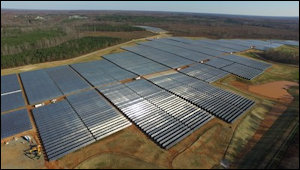
Dominion solar farm. Photo credit: Dominion.
Dominion is investing more than $800 million in solar projects in Virginia totaling 398 megawatts of generation either completed or under development. The projects bring the company within an eyelash of fulfilling a 2015 promise to bring 400 megawatts of large-scale solar generation facilities into service by 2020.
Furthermore, said Dominion in a press release issued today, 80% of that capacity is being covered by large business and government customers ranging from Amazon Web Services to the Commonwealth of Virginia and the University of Virginia. Most of the development and construction cost of the projects will be borne by customers under contract, not passed on to rate payers.
Legislation enacted in 2015 declared that development in Virginia of up to 50 megawatts of solar projects in the state was “in the public interest.”
“We are well ahead of schedule on the solar expansion and what we have added so far will have a very minimal impact on the price of electricity for the 2.5 million regulated customers we serve in Virginia,” said Paul Koonce, CEO of Power Generation at Dominion Energy. “Our goal is to have a balanced generating portfolio that is highly reliable, cost effective and environmentally responsible. The cost of energy powered by the sun is coming down and we are working hard to develop projects in new and economical ways for our customers.”
Bacon’s bottom line: Most of this information has appeared in previous announcements, which raises the question of why Dominion issued this press release at this particular time. The backdrop is the increasing pushback the utility is experiencing by gubernatorial candidates and lawmakers on a variety of fronts. Most significantly, the 2015 deal that froze the base rates of Dominion and Appalachian Power for six years has been re-opened for scrutiny.
With this press release, Dominion is reminding the public that there was more to that 2015 legislative compromise, crafted in response to the Obama administration’s Clean Power Plan, than the rate freeze. The company also committed $57 million over five years to energy assistance to low-income customers and made the 400-megawatt commitment to solar. Reading between the lines, the press release says, “Hey, guys, we made good on the solar promise.”
Bacon’s other bottom line: It’s also apparent — again, reading between the lines — that Dominion management is not persuaded that solar makes economic sense… yet. In other words, its commitment to solar at this point in time is driven by political considerations.
Why do I say that? Because Koonce stresses that the company’s solar investment to date “will have a very minimal impact on the price of electricity.” The implication is that solar would increase the price were it not for the fact that Dominion is building its utility-scale projects by means of long-term contracts with entities willing to pay a premium price for green energy.
The crux of the matter is that solar power is not “dispatchable” — Dominion does not control when it generates solar electricity. It produces electricity only when the sun shines, which does not coincide with periods of peak consumption, and, further, is subject to weather-related interruptions, meaning that electric companies must maintain expensive back-up capacity to fill in.
The vast majority of Dominion’s investment has been in large, utility-scale projects, which are easier to integrate into the high-voltage transmission grid. PJM Interconnection, the regional transmission organization of which Virginia is a part, has said that the region grid could accommodate up to 30% intermittent wind and solar power by redirecting energy flows across a 13-state region.
The dynamics of on-again, off-again production play out differently on the local distribution grid, which lacks the flexibility of the interstate transmission grid. That’s why Dominion has installed 10 experimental, rooftop and other small-scale solar sites around the state: to learn more about how local electric circuits respond to fluctuations in energy output.
Dominion is under tremendous political pressure to accommodate more “distributed generation.” But the economics are very different from utility-scale generation that ties into the transmission grid. Published reports say that the cost of solar could fall to as little as 4 cents per kilowatt hour by 2040. That compares to roughly 11 cents charged by Dominion Virginia Power today. But that still leaves the intermittency issue. While battery storage has been touted as a remedy, battery manufacturers like Tesla are hoping to get the cost down to $100 per kilowatt hour by 2022. There’s still a long way to go before large-scale rooftop deployment is feasible.
Yet in the press release Koonce acknowledged that “the cost of energy powered by the sun is coming down.” So, who knows what the future might bring?


